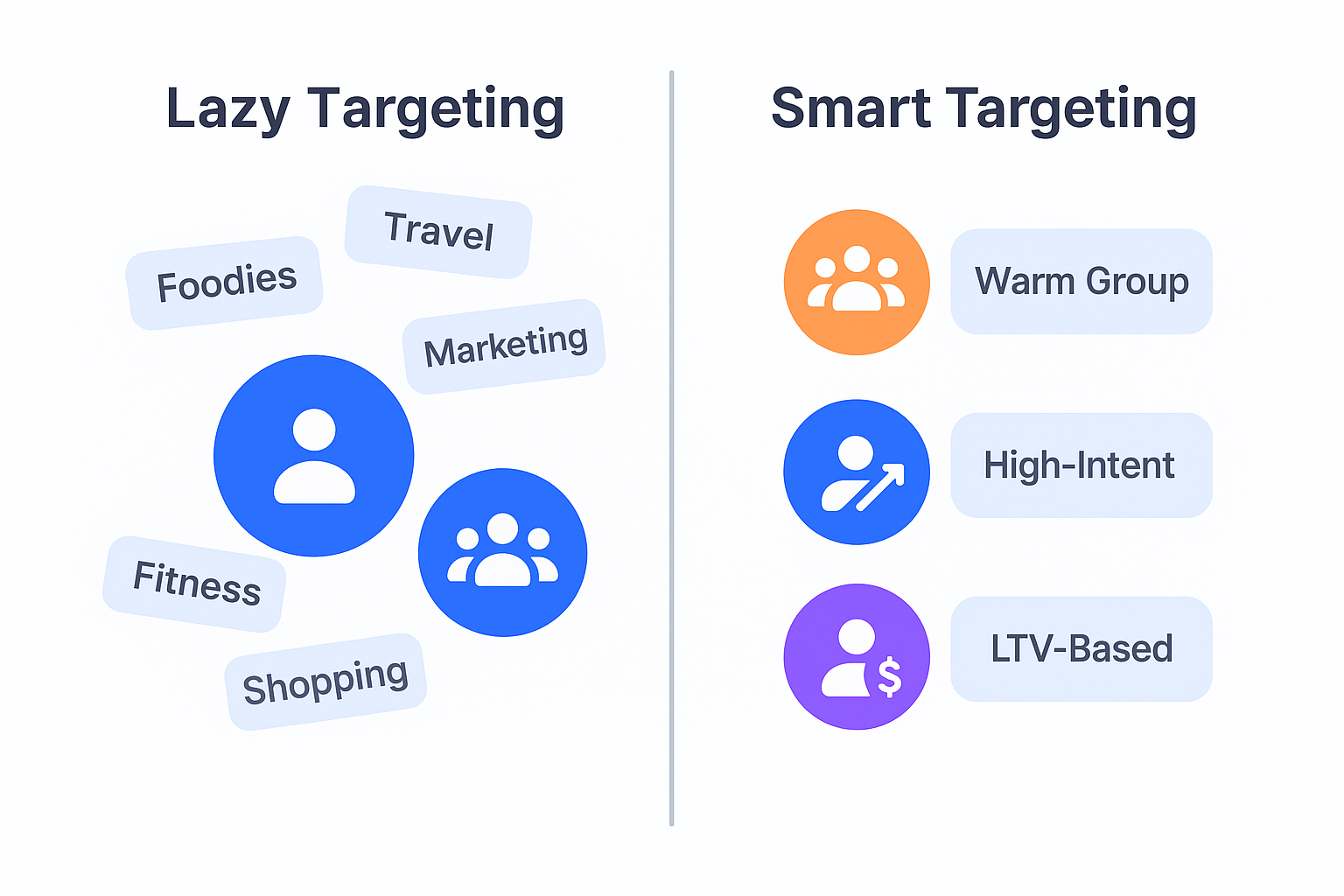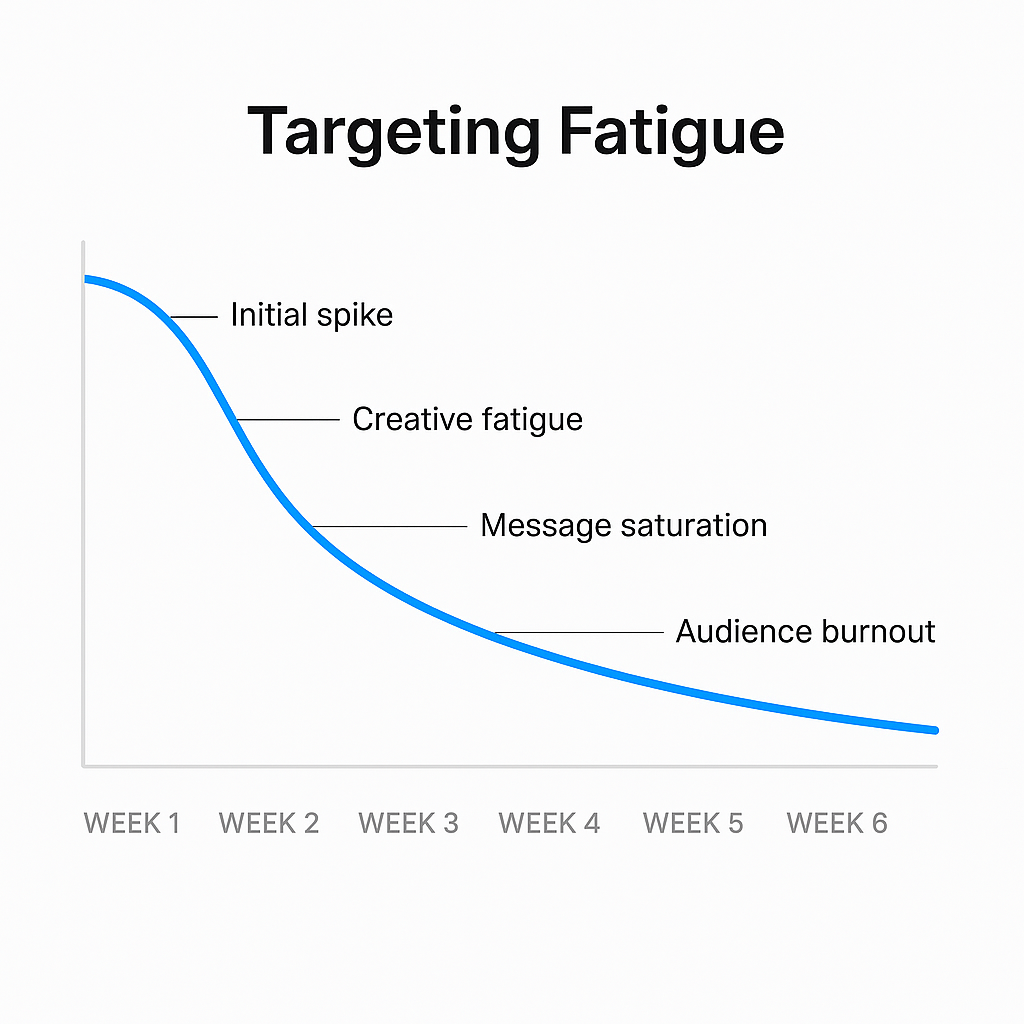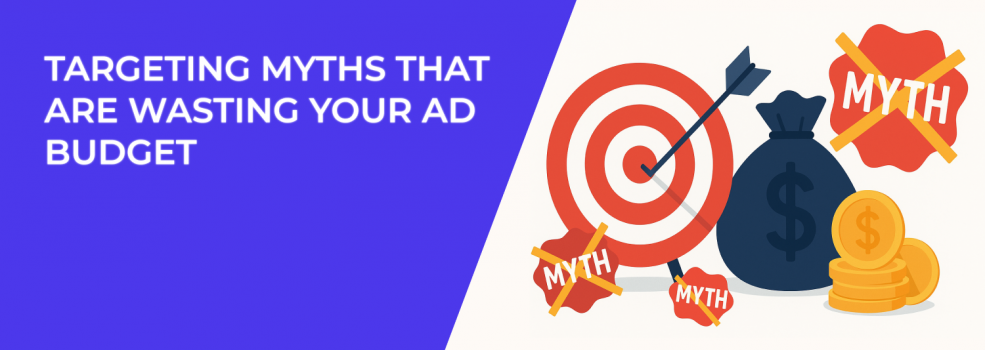You’re running Facebook ads. Maybe even managing a serious budget across Meta, Google, or TikTok. But performance is plateauing. You’ve tried different creatives, adjusted your placements, and maybe even shuffled budgets around. Still — something feels off.
The problem might not be your visuals. Or your copy. Or even your landing page.
It might be who you’re showing your ads to.
Let’s dig into some common targeting myths that quietly sabotage results. These aren’t just beginner mistakes — even experienced advertisers fall for them. And they can drain your ad budget slowly, while keeping your performance just good enough to delay a real fix.
Myth 1: The Algorithm Will Find the Right People for Me
Advertisers are often told to “trust the algorithm.” Meta itself recommends broad targeting, claiming its system will optimize delivery based on performance signals.

There’s truth to that — but here’s the catch: the algorithm doesn’t know who you want until it gets enough data. That means broad campaigns often go through long and expensive learning phases. If you’re not spending heavily, the system may never learn fast enough to deliver consistent results.
For high-ticket, niche, or B2B offers, broad targeting often leads to wasted impressions and random engagement.
Better Approach:
Start by guiding the algorithm, especially in the early stages. Use data-rich, interest-based custom audiences rather than vague demographic filters.
Tools like LeadEnforce let you create custom audiences pulled from Facebook Groups — communities where users are already discussing relevant topics. These signals are stronger than broad interests because they’re tied to active participation, not passive scrolling.
Think about it: Would you rather target people who said they "like marketing" five years ago, or people who recently joined a Facebook Group for B2B lead generation strategies?
Learn more in this breakdown of Facebook’s targeting challenges and fixes.
Myth 2: Lookalikes Always Outperform Interests
Lookalikes used to be the gold standard for scaling. They still work — but only if your seed audience is clean and strategically chosen.

Most advertisers build lookalikes from:
-
All purchases,
-
Website visitors,
-
Pixel events.
But that’s not enough. A lookalike is only as good as the data you give it.
Smarter Strategy:
Instead of giving Meta your entire buyer list, upload a segmented list of your highest-value customers. Add a purchase value column if possible. This allows Meta to create value-based lookalikes — meaning the algorithm will prioritize people with behaviors and profiles similar to your most profitable buyers, not just anyone who completed a purchase.
If you’re using email sign-ups as a source, consider:
-
Time since opt-in (recent leads tend to be more relevant),
-
Engagement level (clicked or replied to emails),
-
Customer tags (e.g. VIPs, repeat buyers).
Also: don’t treat interests as outdated. Layering one to two relevant interest filters over your lookalikes can create a hybrid audience that’s both large and targeted.
Learn how to implement value-based lookalikes properly.
Myth 3: Retargeting Is Just for Abandoned Carts
This one’s especially common in e-commerce — and it’s leaving revenue on the table.
Retargeting isn’t just about abandoned checkouts. It’s about re-engaging people based on behavior — and behavior doesn’t always mean adding to cart.
Build Smarter Retargeting Segments:
Here’s how you can structure your retargeting campaigns to reflect actual user intent:
-
Pageview-based: People who visited key pages but didn’t convert. Tailor messages based on what they saw — e.g., show UGC or reviews for the exact product viewed.
-
Time-on-site filters: Focus on those who spent time reading or scrolling. They’re more likely to be evaluating, not bouncing.
-
Content engagement: If someone read a blog post, watched a product video, or downloaded a guide, use that signal. Offer a free trial, an invite to a webinar, or a product walkthrough.
-
Repeat visitors: People who came back multiple times are prime for retargeting with urgency messaging — think "Still thinking about it?" or "Low stock alert."
Want to rethink how you use mid-funnel targeting? This post on retargeting vs broad targeting is worth a read.
Myth 4: Narrowing My Targeting Too Much Will Hurt Delivery
There’s truth to this, but let’s break it down.
Narrowing your audience badly — by stacking multiple interests, age limits, job titles, behaviors, exclusions, and placements — is a recipe for throttled delivery and high CPMs.

But intentional segmentation is something else entirely.
What Smart Narrowing Looks Like:
Instead of slicing your audience by interests alone, think in terms of motivations, life stage, and buying context.
For example, if you’re selling a fitness coaching program:
-
One audience could be 9–5 desk workers with back pain.
-
Another could be busy parents looking to work out at home.
-
A third might be gym-goers struggling with weight loss plateaus.
Each of those groups needs a different message, different creative, and different tone.
To build segmentation like this, you need more than just interests. This audience building guide can help.
Myth 5: The More Detailed Targeting, the Better
When advertisers aren’t sure who to target, the instinct is to layer everything.
They’ll add:
-
Age range,
-
Gender,
-
Job title,
-
Purchase behavior,
-
Multiple interests,
-
Device usage,
-
Income level.
What they don’t realize is — every added filter restricts delivery. And more restrictions mean higher ad costs and lower reach.
The Real Problem:
You’re not letting the algorithm learn. You’re cornering it.
Instead of layering seven qualifiers, try this:
-
Choose one to two strong signals based on actual buying behavior.
-
Avoid overlapping interests (e.g., “Online Courses” and “E-learning” likely share a huge audience).
-
Don’t combine high-value behaviors with generic ones — keep them in separate ad sets for cleaner data.
This myth-busting article on ad targeting failures goes deeper into this trap.
Myth 6: Once an Audience Works, I Can Keep Using It Forever
Audiences fatigue, markets shift, competitors copy. Consumer behavior changes with the season, economy, or even just the weather.
If your once-great audience is suddenly underperforming, it doesn’t mean your product stopped being good. It means the context changed.

What You Can Do:
-
Rotate creatives — but also refresh your audience sources. Pull updated customer lists, look at CRM engagement, or re-import new Group-based segments using LeadEnforce.
-
Use recency filters — people who visited your site 3 days ago are different from those who visited 30 days ago. Segment accordingly.
-
Test intent tiers — for example:
-
Tier 1: Viewed product page 3+ times,
-
Tier 2: Added to cart,
-
Tier 3: Initiated checkout.
-
And remember: smart exclusions keep your frequency from creeping up too fast.
Want to avoid confusing results from mixed audiences and creatives? This guide to split testing properly will help.
Final Thoughts: Don’t Let Lazy Targeting Steal Your ROAS
Great ads aren’t just about creative. They’re about relevance. And relevance starts with showing the right message to the right person at the right time.
The easiest way to burn your ad budget? Keep trusting myths like these:
-
That Meta always knows best,
-
That lookalikes are perfect,
-
That retargeting is for cart abandoners only,
-
That broad or detailed targeting will always win.
The advertisers getting the best results today aren’t the ones spending the most — they’re the ones questioning what everyone else assumes. Break the myth cycle, and your targeting will finally start pulling its weight.

